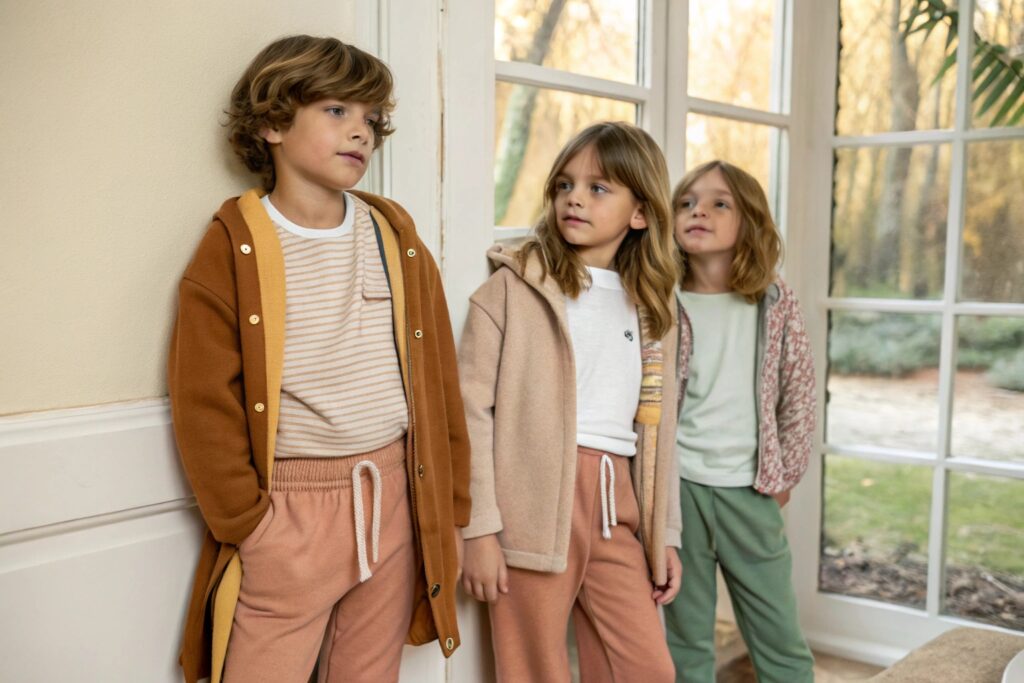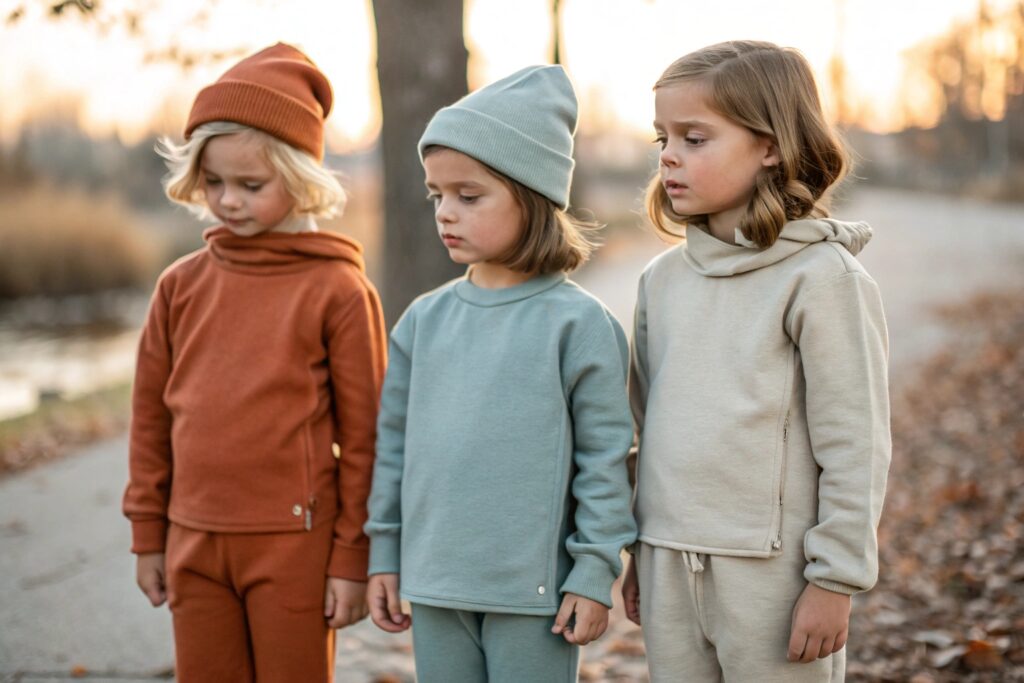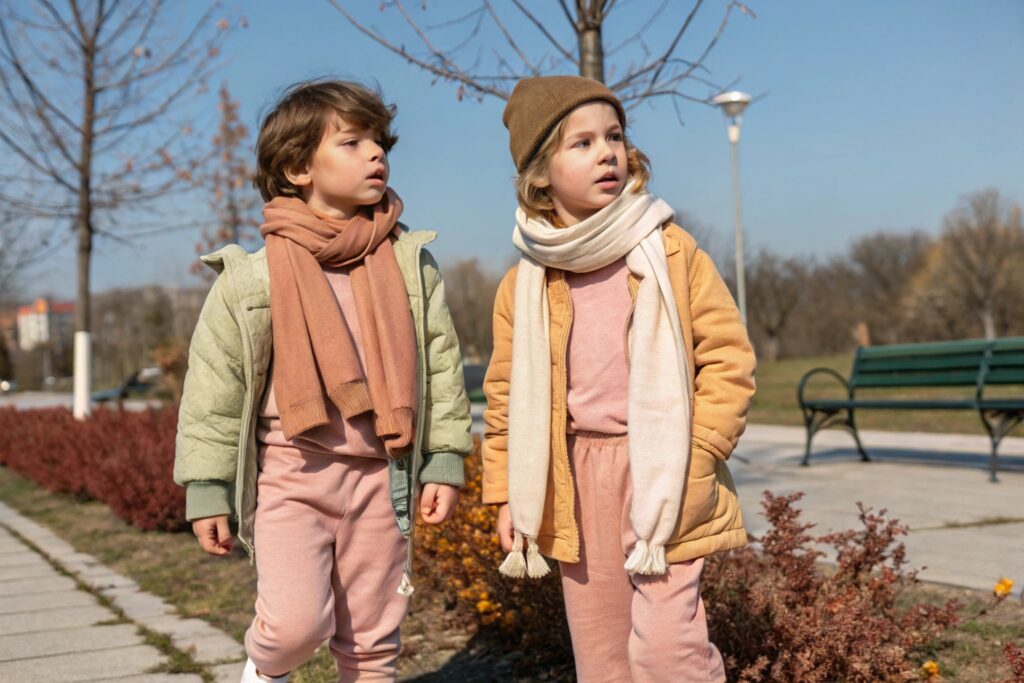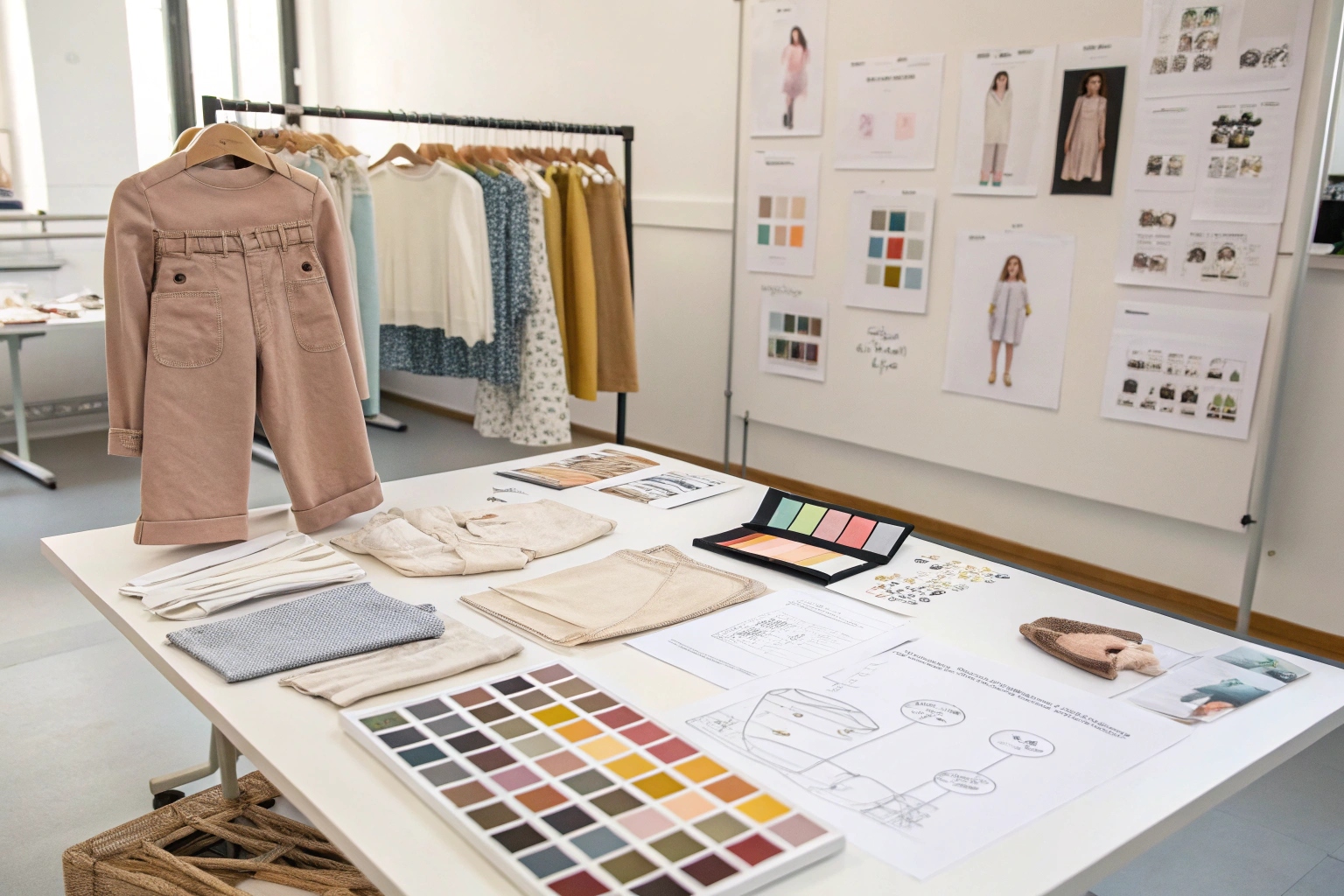Struggling to balance fashion trends, durability, and simplicity in your kidswear line?
A successful capsule collection for kidswear focuses on essential, mix-and-match pieces that are easy to style, comfortable to wear, and cost-effective to produce.
If you’re sourcing or manufacturing kidswear, this article will walk you through the key design strategies that make capsule collections both marketable and practical.
Key Essentials for a Kids’ Capsule Wardrobe?
Are you unsure which items actually belong in a capsule collection?
A well-designed kids’ capsule wardrobe includes tops, bottoms, outerwear, and layering pieces that all coordinate easily and serve multiple purposes.

Which garment types should always be included in a kids’ capsule wardrobe?
Most successful capsule wardrobes include about 15–25 pieces. These are typically split into essential categories:
- Tops (5–7 pieces): basic tees, long sleeves, tank tops
- Bottoms (3–5 pieces): leggings, joggers, shorts
- Outerwear (1–2 pieces): a neutral jacket or zip-up hoodie
- One-pieces (2–3 pieces): jumpsuits or dresses for versatility
- Layering items (2–3 pieces): cardigans, vests, thermals
These pieces are designed to cover school days, weekends, and casual outings. For clothing brands, it’s critical to offer options that overlap in function but are different enough to feel fresh when worn in rotation.
At Fumao Clothing, we work with partners to build capsule lines that include these foundational categories. We help our clients minimize redundancy while maximizing outfit combinations.
How do I avoid including too many items in a capsule collection?
It’s tempting to add more SKUs to feel complete, but that defeats the purpose. The trick is intentional design. Focus on versatility. For instance, a striped shirt should pair with at least three types of bottoms. A neutral hoodie should match every item underneath.
Here’s a sample 16-piece capsule lineup:
| Category | Item | Quantity |
|---|---|---|
| Tops | Solid T-shirt, striped tee | 4 |
| Bottoms | Black leggings, denim shorts | 3 |
| One-pieces | Cotton dress, romper | 2 |
| Outerwear | Light jacket | 1 |
| Layering | Cardigan, fleece vest | 2 |
| Sleepwear | Pajama set | 2 |
| Wildcard | Graphic tee, occasion top | 2 |
Stick to foundational needs, and let every piece earn its place.
How to Choose Colors for Children’s Capsule Lines?
Do you worry about how to balance trends with timelessness?
Choosing the right colors means focusing on a neutral base and adding just a few accent shades that match well across seasons.

What is the ideal color palette for a gender-neutral kids’ capsule collection?
A strong capsule starts with a foundation of neutrals—think heather gray, off-white, tan, navy. These serve as your canvas. Then, introduce accent colors like dusty rose, olive green, or mustard yellow. These add personality without clashing.
The goal is cross-matching. Every top should match most bottoms. Every accent color should complement the base neutrals. That means fewer returns and more wear time.
Here’s a simple structure we recommend to our clients at Fumao Clothing:
| Color Type | Example Shades | Use Case |
|---|---|---|
| Base Neutrals | White, Charcoal, Beige | Tops, bottoms |
| Soft Colors | Sky Blue, Sage, Rose | Dresses, tees, trims |
| Bright Accents | Coral, Lemon, Turquoise | Graphic elements, linings |
This mix gives retailers room to inject style while keeping the overall line cohesive.
How do colors influence parents’ purchasing decisions?
Parents often shop with their emotions. A peaceful palette evokes order. A cheerful one feels playful. But too many bright or contrasting colors make mixing difficult. This leads to frustration and less frequent use.
We’ve seen clients boost conversion rates just by toning down their color palettes. One brand went from neon-heavy pieces to a muted capsule design and saw a 38% decrease in returns.
Color planning isn’t just visual—it’s psychological. Choose shades that signal trust, function, and calm. If you’re uncertain, start with muted earth tones and test seasonal accents through limited drops.
Best Fabrics for Kids’ Capsule Clothing Collections?
Are you wondering what materials hold up best in kidswear capsules?
The best fabrics are breathable, soft, durable, and able to withstand frequent washing without losing their shape or color.

What natural fabrics are most suitable for everyday capsule pieces?
Natural fibers like organic cotton, bamboo, and linen blends are often preferred by parents. They’re breathable and gentle on the skin. Organic cotton, in particular, is the star of most capsule wardrobes.
Here’s how the top natural fabrics compare:
| Fabric | Pros | Use Cases |
|---|---|---|
| Organic Cotton | Soft, hypoallergenic, long-lasting | Tees, leggings, pajamas |
| Bamboo Rayon | Breathable, anti-bacterial, silky feel | Undergarments, bodysuits |
| Linen Blends | Cool, lightweight, natural texture | Dresses, shorts, rompers |
At Fumao Clothing, we ensure fabric sourcing is both ethical and high-performance. Our QC team rigorously tests wash durability, color retention, and shrink resistance—so buyers like Ron can offer clothes that stay sold.
What synthetic blends work best for outerwear and durability?
While parents love natural fabrics, a capsule collection isn’t complete without smart synthetics. Cotton-polyester blends, fleece, and spandex-infused knits provide structure, stretch, and resilience.
Use synthetics wisely. Avoid plastic-feel textiles. Look for OEKO-TEX certified options to meet global compliance.
In outerwear, we recommend:
- Brushed fleece: soft and warm
- Stretch French terry: good for activewear
- Water-repellent polyester blends: perfect for jackets
These options reduce bulk while increasing function. They also help your line pass the mom test—will this survive a playground, a puddle, and a playdate? If yes, it stays.
Tips for Planning Seasonal Kidswear Capsules?
Not sure how to adapt capsules for different seasons?
Seasonal capsules focus on layering, fabric weight, and accessories, using a core wardrobe that stays consistent throughout the year.

What are the key differences between summer and winter capsule designs?
The base stays the same, but the layers evolve. In warmer months, you want breathable fabrics, shorter sleeves, and moisture-wicking materials. In colder months, switch to thicker knits, fleece-lined pieces, and accessories like hats and mittens.
Here’s a basic comparison of seasonal swaps:
| Category | Summer Capsule | Winter Capsule |
|---|---|---|
| Tops | Sleeveless tees, crop tanks | Long sleeves, thermals |
| Bottoms | Shorts, linen pants | Fleece leggings, joggers |
| Outerwear | Light hoodie | Padded jacket, wool coat |
| Footwear | Sandals | Boots, thick socks |
| Accessories | Caps, sunglasses | Scarves, beanies, gloves |
A smart approach is to design the core collection once, then add or remove 4–5 pieces per season to create Spring/Summer and Fall/Winter capsules.
How far in advance should brands plan seasonal capsule drops?
Six months is standard. If you’re targeting Spring drops, start development in September. For Fall/Winter, begin by March. This ensures enough time for prototyping, production, and shipping—especially if you’re working with overseas suppliers.
One of our key value propositions at Fumao Clothing is on-time delivery. Seasonal delays are a brand killer. That’s why our clients trust our streamlined calendar-based planning, factory-direct communication, and DDP logistics.
Build your calendar backwards from your sales window. Include buffer time for testing and marketing assets. A well-timed drop doesn’t just sell well—it earns parent loyalty.
Conclusion
Designing a kidswear capsule collection takes strategy, consistency, and a strong focus on comfort and coordination—three things parents value most when choosing clothing for their kids.










